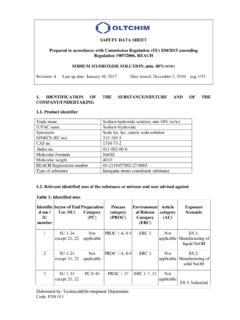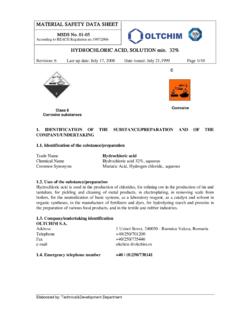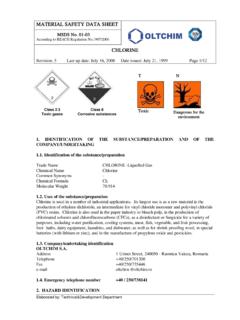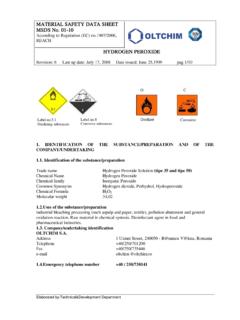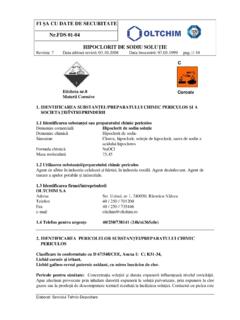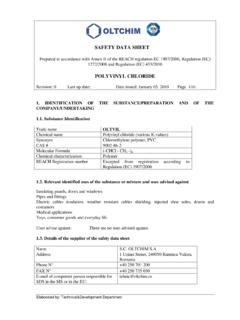Transcription of MATERIAL SAFETY DATA SHEET MSDS No. 01-01 - Oltchim
1 MATERIAL SAFETY data SHEETMSDS No. 01-01 According to REACH Regulation hydroxide SOLUTIONR evision: 6 Last up date: July 17, 2008 Date issued: February 2, 2000 pag. 1/9 Elaborated by: Technical &Development Department1. IDENTIFICATION OF THE SUBSTANCE/PREPARATION AND OF Identification of the substance/preparationTrade NameSodium hydroxide solutionChemical Name sodium hydroxide solutionChemical Family Inorganic basesCommon Synonyms Soda lye, lye.
2 Caustic soda solutionChemical Formula NaOHMolecular Weight Uses of the substance/preparationThe main uses of sodium hydroxide are in chemical manufacturing (pH control, acid neutralization,off-gas scrubbing and catalyst); pulp and paper manufacturing; in petroleum and natural gasindustry (removing acidic contaminants in oil and gas processing); manufacture of soap anddetergents and other cleaning products; and celluloses, such as rayon, cellophane and celluloseethers; cotton mercerizing and scouring.
3 Other uses include water treatment, food processing, flue-gas scrubbing, mining, glass making, textile processing, refining vegetable oils, rubber reclamation,metal processing, aluminium processing, metal degreasing, adhesive preparations, paint remover, Company/undertaking identificationOLTCHIM 1 Uzinei Street, 240050 - Ramnicu Valcea, RomaniaTelephone +40/250/701200 Fax +40/250/735446e-mail telephone number +40 / 0250/738141 CCorrosiveLabel substancesSODIUM hydroxide SOLUTIONMSDS No.
4 01-01 Revision: 6 Last up date: July 17, 2008 Date issued: February 2, 2000 pag. 2/102. HAZARDS IDENTIFICATIONEC Classification according to Directive 67/548/CEE, Annex IC; R35 Corrosive liquidCause burnsHealth effects: sodium hydroxide causes severe burns of the eyes, even blindness. In skin contactcan cause severe burns. sodium hydroxide may be fatal if swallowed. Breathing the droplets ofsolution can irritate the mouth, nose and throat. Exposure to high levels may irritate the lungs,causing coughing and/or shortness of breath.
5 Still higher exposure can cause a build up of fluid inthe lungs (pulmonary oedema).Environmental effects:Considering its high water solubility, sodium hydroxide is not expected tobio accumulate in organism. sodium hydroxide is slightly toxic in the aquatic environment. Thetoxic effect on aquatic organism is due pH increasing. When released into the soil this MATERIAL mayleach into groundwater. During movement through soil, some ion exchange will occur. Sodiumhydroxide is not classified as dangerous for environmental as specified in Directive 67/548/EEC,Annex overview: sodium hydroxide is a corrosive liquid.
6 It is a non flammable substance, butmay ignite combustibles (wood, paper, oil). In contact with some metals (cooper, aluminium, tin,zinc, and there alloy) release flammable hydrogen which may cause fire and COMPOSITION/INFORMATION ON INGREDIENTSH azardouscomponents/constituentsConcentra tion%, No. EC No. Annex IIndex R35 FIRST - AID MEASURESSeek medical attention immediately in all cases of exposure!Inhalation: Severe irritant. Symptoms may include sneezing, sore throat or runny nose. Remove tofresh air. If not breathing, give artificial respiration.
7 If breathing is difficult, give oxygen. Call aphysician contact: Corrosive! Contact with skin can cause irritation or severe burns and scarring withgreater exposures. Remove contaminatedclothes and shoes. Rinse skin with plenty of water for atleast 30 minutes until slippery feeling disappears. Seek medical attention immediately. Washclothing before hydroxide SOLUTIONMSDS No. 01-01 Revision: 6 Last up date: July 17, 2008 Date issued: February 2, 2000 pag. 3/10 Eye contact:Extremely irritating/corrosive. Contact with the liquid causes painful, redness, blurredvision and severe deep flush eyes with high amounts of water for at least 30 minutes, lifting lower and uppereyelids occasionally.
8 Seek medical attention : Swallowing may cause severe burns of mouth, throat, and stomach. Symptoms mayinclude bleeding, vomiting, diarrhea, fall in blood pressure. Damage may appear days a physician immediately. Do not induce vomiting. If conscious, give large amounts of water ormilk if give anything by mouth to an unconscious to Physician:No specific endoscopy in all cases of suspected sodiumhydroxide ingestion. In cases of severe esophageal corrosion, the use of therapeutic doses ofsteroids should be considered.
9 General supportive measures with continual monitoring of gasexchange, acid-base balance, electrolytes and fluid intake are also Measure:Caustic soda must be removed as quickly as possible by washing with wateronly. Do not attempt to neutralize the caustic soda with chemicals. Continue washing for 30minutes or until advised by physician. A hospital cannot provide better emergency aid than waterfor caustic soda FIRE - FIGHTING MEASURESS uitable extinguishing media:Use media appropriate for surrounding fires (powder, foamextinguishing agents or carbon dioxide).
10 Unsuitable extinguishing media:Avoid water use if water to caustic solutiongenerates large amounts of hazards: Not considered to be a fire hazard. Violent steam generation or eruption mayoccur upon application of direct water stream to hot liquids. sodium hydroxide can react withcertain metals, such as aluminum and zinc to generate flammable hydrogen gas. sodium hydroxideitself does not burn, but poisonous gases are produced in of fire-fighters:Firefighters should wear proper protective equipment and self containedbreathing apparatus with full face-piece operated in positive pressure ACCIDENTAL RELEASE MEASURESP ersonal precautions: Ventilate area of leak or spill.
